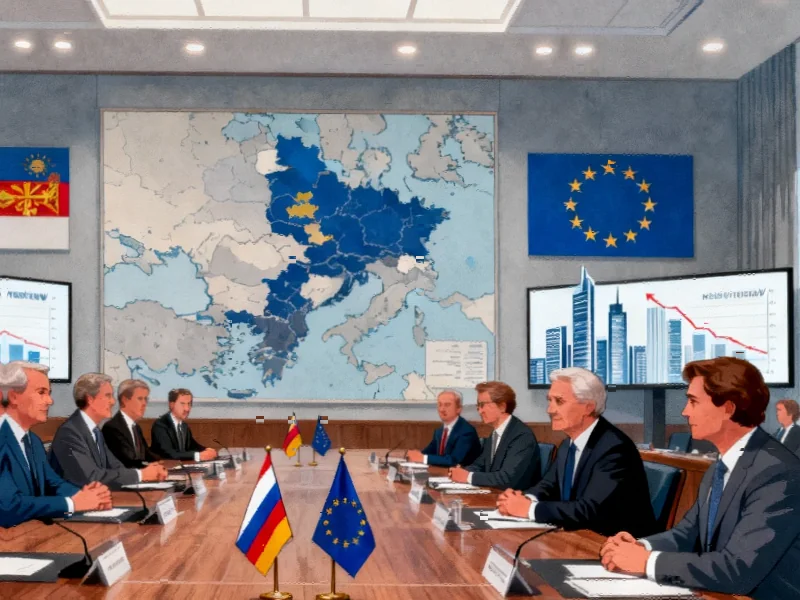Strategic Implications for European Security Architecture
The announcement that Budapest will host the next Trump-Putin summit represents more than just another diplomatic meeting—it signals a potential realignment in European security relationships that could have lasting consequences for technology cooperation and industrial computing partnerships across the continent. The choice of Hungarian Prime Minister Viktor Orbán as host, despite his government’s consistent opposition to EU consensus on Russia sanctions, underscores how geopolitical positioning is increasingly influencing technological sovereignty initiatives.
Table of Contents
European capitals have expressed concern that this summit could undermine collective security frameworks that have enabled cross-border data flows and research collaborations. As one EU diplomat noted, “We’re all grinning through our teeth whilst saying this is fine,” reflecting the tension between diplomatic protocol and genuine apprehension about the implications for European unity on security matters that directly affect industrial and technological cooperation.
Hungary’s Balancing Act Between East and West
Prime Minister Orbán’s positioning as intermediary between Washington and Moscow comes at a critical juncture for Hungary’s technological development. Despite being an EU and NATO member, Hungary has pursued energy deals and technology partnerships with Russia that sometimes put it at odds with broader European initiatives. This summit represents what analyst Jennifer Kavanagh calls “a big win for Orbán,” elevating Hungary’s diplomatic status while potentially complicating its participation in EU technology programs.
The timing is particularly significant given ongoing debates about European strategic autonomy in critical technologies. As Botond Feledy, a Hungarian geopolitical expert based in Brussels, observed, this development “is precisely what Europeans have sought to avoid from the start” in terms of maintaining unified positions on security matters that intersect with technology policy and industrial computing security standards.
Industrial and Computing Security Dimensions
The summit’s location raises questions about how cybersecurity and industrial control system protections might be affected by shifting diplomatic alignments. European manufacturers and technology firms have expressed concern about maintaining consistent security protocols when political relationships become more fragmented. The German position, articulated by EU minister Gunther Krichbaum, emphasizes that “Ukraine has to sit at the table” in any settlement discussions, reflecting broader European concerns about establishing precedents that might compromise security guarantees for nations bordering Russia.
This diplomatic development occurs alongside ongoing EU efforts to use frozen Russian assets for a €140bn loan to Ukraine and implement new sanctions targeting Moscow’s revenues—measures that Hungary has frequently opposed or sought to dilute. The tension between individual member state diplomacy and collective EU action creates uncertainty for technology companies operating across European borders, particularly those involved in industrial computing systems that require stable international relationships for secure operation.
Historical Context and Future Trajectories
The symbolism of Budapest as a venue carries particular weight given the 1994 Budapest Memorandum, in which Ukraine received security assurances in exchange for relinquishing its nuclear arsenal—assurances that proved inadequate when Russia annexed Crimea and invaded Ukraine. As one EU diplomat noted, comprehensive coverage,, officials have “pointed out that there already was one deal done in Budapest and it did not end that well for Ukraine,” highlighting concerns that history might repeat itself in ways that could destabilize the security environment essential for technological innovation and industrial growth.
President Zelenskyy’s cautious response—expressing skepticism about the venue while remaining open to participation—reflects the delicate balance smaller nations must strike in navigating great power diplomacy. His observation that “if it can bring peace, [the setting] will not matter” acknowledges the primacy of security outcomes over procedural concerns, while his criticism of Orbán as someone who “blocks Ukraine everywhere” underscores how bilateral relationships can complicate multilateral technology and security cooperation.
Broader Implications for European Technology Cooperation
The summit comes as EU leaders prepare to discuss using Russian frozen assets to support Ukraine and implement new sanctions—decisions that require consensus and which Hungary has historically complicated. The prospect of Hungary positioning itself as a bridge between Washington and Moscow could either facilitate diplomatic breakthroughs or further fragment European unity on matters affecting industrial and computing security standards.
As European nations work to strengthen their technological sovereignty and secure industrial computing infrastructure against emerging threats, maintaining coherent foreign policy positions remains essential. The Budapest summit will test whether individual member states can pursue distinctive diplomatic relationships while preserving the collective action necessary for effective technology security policy across the European single market.
With Hungarian elections approaching in spring, the diplomatic spotlight on Orbán’s government adds another layer of complexity to European technology and security coordination. The outcome may influence how European nations balance individual diplomatic initiatives with collective technology security imperatives in an increasingly contested international environment.
Related Articles You May Find Interesting
- Microsoft’s Cryptographic Shift Sparks Enterprise Chaos: When Security Updates B
- New Research Uncovers Chemotherapy’s Hidden Impact on Brain Function Through Lym
- German Retail Investors Gain Access to Private Equity Through New Banking Partne
- Ardagh’s $10 Billion Restructuring Faces Deutsche Bank Challenge Amid Bondholder
- How Kraken’s Software Platform Became More Valuable Than Octopus Energy’s Retail
This article aggregates information from publicly available sources. All trademarks and copyrights belong to their respective owners.
Note: Featured image is for illustrative purposes only and does not represent any specific product, service, or entity mentioned in this article.
